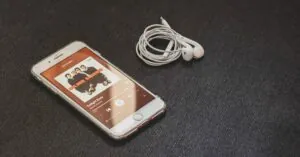Table of Contents
ToggleLosing a dead iPhone in the depths of your home can feel like searching for a needle in a haystack—if the haystack was made of couch cushions and laundry. It’s the ultimate game of hide and seek, but this time, the stakes are higher. Without that trusty device, how will anyone know you’re still alive?
Fear not! With a few clever strategies, you can track down your elusive gadget and reclaim your connection to the world. Whether it’s buried under a mountain of blankets or hiding in the depths of a forgotten bag, finding your dead iPhone doesn’t have to be a Herculean task. Let’s dive into some practical tips that’ll turn you into a modern-day Sherlock Holmes, minus the deerstalker hat—unless you’re into that sort of thing.
Understanding the Problem
Finding a dead iPhone in a house presents unique challenges. Despite the frustration it causes, understanding potential issues and common hiding spots can simplify the search.
Why Your iPhone Might Be Dead
Several factors contribute to an iPhone’s battery dying. Overuse leads to rapid battery drain, especially when apps run in the background. Environmental factors play a role too; extreme temperatures can affect battery health. Accumulation of dust or dirt inside charging ports may obstruct charging. Further, neglecting updates can cause software issues that drain battery life. Recognizing these factors aids in preventing future occurrences of a dead iPhone.
Common Locations for Misplaced iPhones
Common locations often conceal misplaced iPhones. Cushions on sofas frequently hide devices, as they slide between them easily. Bedrooms hold many hiding spots; under pillows or between sheets often conceals phones. Kitchens also account for several misplaced iPhones as counters and drawers become cluttered. Garages, though less common, can still hide devices among tools and boxes. Each of these areas warrants careful searching to ensure the iPhone’s safe retrieval.
Methods to Locate a Dead iPhone
Finding a dead iPhone involves specific techniques. Effective methods enable quick retrieval, even from unexpected places.
Using Find My iPhone
Accessing Find My iPhone provides a straightforward way to locate the device. Even if the iPhone is dead, this feature shows its last known location. Log into iCloud on a computer or another Apple device, then select the Find My iPhone option. The map displays the device’s last whereabouts, often revealing where it was before the battery died. If the device’s location is clear, proceed directly to that spot. Otherwise, plan a systematic search in surrounding areas to explore possibilities.
Physical Search Techniques
Conducting a thorough physical search involves checking common hiding spots first. Start with areas like sofa cushions, under beds, and inside drawers. Look in less obvious places, including laundry baskets or bags. Utilize a flashlight to illuminate dark spaces, making it easier to spot the iPhone. Search quietly to hear any alerts or notifications, as a sound might help locate it. Tackling one room at a time ensures a focused search, reducing the likelihood of overlooking potential hiding spots.
Tips for Effective Searching
Effective searching requires organization and teamwork. Focus on systematic methods to ensure a higher chance of finding the lost device.
Creating a Checklist
Creating a checklist aids in maintaining an organized search. Start by listing common hiding spots, including couch cushions, under beds, and inside drawers. Identify where the iPhone was last seen, marking that location as the priority. Include any typical areas where the phone may have been misplaced, like the bathroom or car. Checking off each area as it’s searched helps prevent retracing steps. Adjust the list as necessary, ensuring all likely locations are covered during the search.
Involving Family Members
Involving family members increases the search’s effectiveness. Recruit assistance from others to cover more ground and avoid overlooking potential spots. Assign specific areas to each person, ensuring everyone searches diligently. During the search, encourage communication about any findings or thoughts on where the iPhone might be. Bringing everyone together not only quickens the process but also boosts morale, making the task less frustrating. Sharing the responsibility simplifies the effort, ensuring no area goes unexamined.
Preventive Measures for the Future
Taking steps to prevent future occurrences of a dead iPhone makes finding it easier. Implementing specific strategies can help keep the device accounted for.
Keeping Track of Your Device
Utilizing a tracking app significantly aids in locating a mobile device. Owners can enable features like Find My iPhone to receive notifications for a misplaced phone. Regularly checking the device’s location before disconnecting can ensure it’s not left behind. Designating a specific spot for the phone when not in use helps avoid unnecessary searches. Additionally, attaching a locator sticker or tag provides an extra layer of security, increasing the chances of recovery if lost.
Charging Habits to Avoid Dead Batteries
Maintaining healthy charging habits goes a long way in preventing dead batteries. Regularly charging the iPhone at intervals avoids complete battery drainage. Plugging it in at night ensures a fully charged device by morning, ready for use. Using certified chargers and avoiding overnight charging helps prolong battery life. Limiting the use of background applications conserves battery power, reducing the frequency of charging needed. Monitoring battery health through settings also provides insights for better maintenance practices.
Finding a dead iPhone in the house can be a frustrating experience but it’s not impossible. By employing the right strategies and techniques readers can increase their chances of successfully locating their device. Careful organization and teamwork can make the search process more efficient and less stressful.
Additionally understanding the reasons behind a dead iPhone can help prevent future occurrences. Implementing preventive measures like using tracking apps and maintaining good charging habits can keep devices accounted for. With these tips in mind readers can ensure their iPhone stays connected and easily retrievable in the future.




